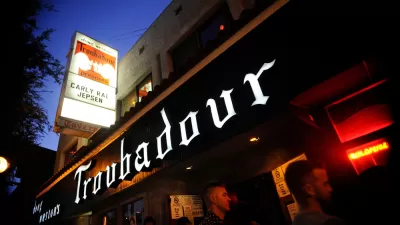In his latest film, “Her,” Spike Jonze presents a one-of-a-kind vision of L.A.'s future.
Unlike other filmmakers, Jonze neither indulges in what one music critic has coined “Retromania,” nor does he imagine a uniformly dystopian or utopian future. Instead, writes Christopher Hawthorne, he finds a thought-provoking middle ground.
Jonze drew on two sources to create the Los Angeles seen in “Her”: first, he digitally altered the city’s existing skyline, with input from architect Elizabeth Diller. Second, he shot more than a few scenes in Shanghai.
“Filming in Shangai . . . allows him to capture something significant about the character, and the anxieties, of contemporary L.A.,” Hawthorne writes. “This is a city caught in limbo between two very different kinds of urbanism: between its private and car-dominated past and denser, more public and more connected future.”
FULL STORY: Spike Jonze's 'Her' a refreshingly original take on a future L.A.

Planetizen Federal Action Tracker
A weekly monitor of how Trump’s orders and actions are impacting planners and planning in America.

Congressman Proposes Bill to Rename DC Metro “Trump Train”
The Make Autorail Great Again Act would withhold federal funding to the system until the Washington Metropolitan Area Transit Authority (WMATA), rebrands as the Washington Metropolitan Authority for Greater Access (WMAGA).

The Simple Legislative Tool Transforming Vacant Downtowns
In California, Michigan and Georgia, an easy win is bringing dollars — and delight — back to city centers.

The States Losing Rural Delivery Rooms at an Alarming Pace
In some states, as few as 9% of rural hospitals still deliver babies. As a result, rising pre-term births, no adequate pre-term care and harrowing close calls are a growing reality.

The Small South Asian Republic Going all in on EVs
Thanks to one simple policy change less than five years ago, 65% of new cars in this Himalayan country are now electric.

DC Backpedals on Bike Lane Protection, Swaps Barriers for Paint
Citing aesthetic concerns, the city is removing the concrete barriers and flexposts that once separated Arizona Avenue cyclists from motor vehicles.
Urban Design for Planners 1: Software Tools
This six-course series explores essential urban design concepts using open source software and equips planners with the tools they need to participate fully in the urban design process.
Planning for Universal Design
Learn the tools for implementing Universal Design in planning regulations.
Smith Gee Studio
City of Charlotte
City of Camden Redevelopment Agency
City of Astoria
Transportation Research & Education Center (TREC) at Portland State University
US High Speed Rail Association
City of Camden Redevelopment Agency
Municipality of Princeton (NJ)




























